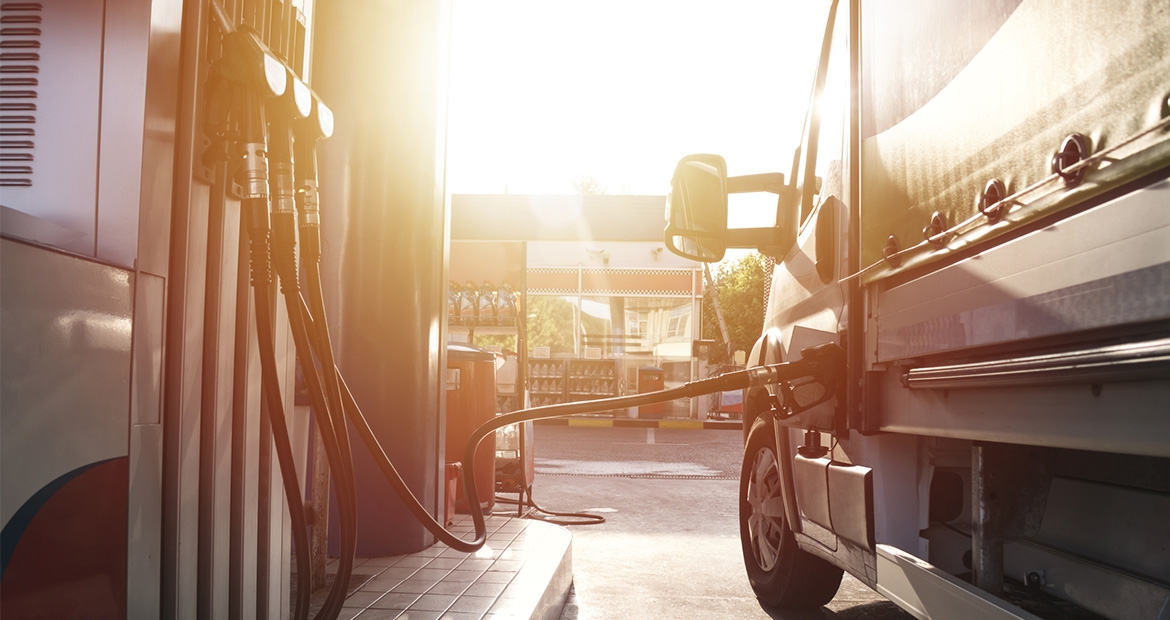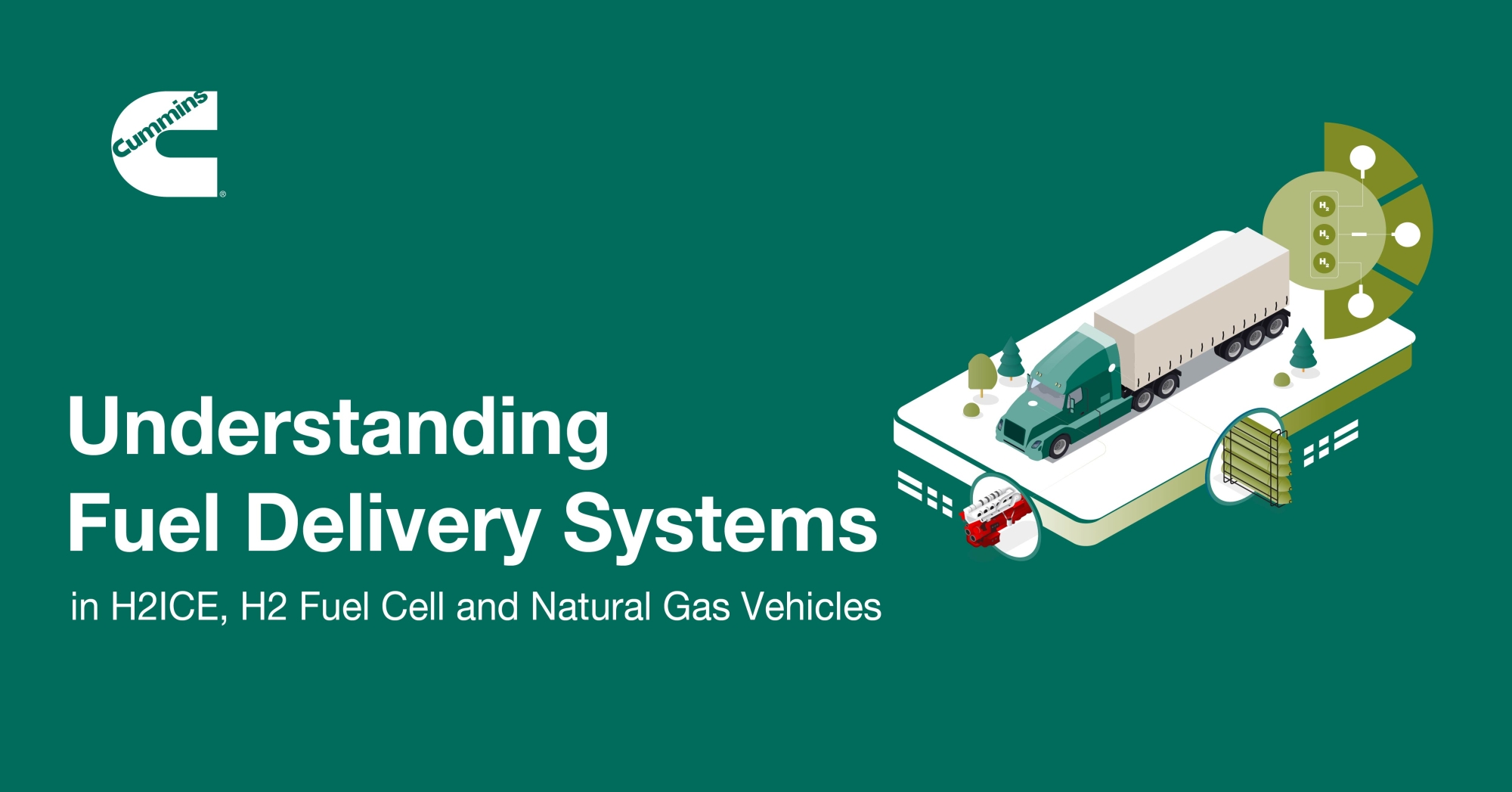How does the fuel delivery system work for hydrogen ICE, hydrogen fuel cell and natural gas vehicles?
By Cummins Inc., Global Power Technology Leader

What is the fuel delivery system?
The fuel delivery system is one of the most critical components in a vehicle and is the heart of a vehicle's power generation process. The fuel delivery system serves a similar function to a fuel tank in diesel-powered vehicles.
However, the fuel delivery system is specifically designed to handle gaseous fuels like hydrogen and natural gas, both of which are stored at high pressures.
This article explores key details of fuel delivery systems for hydrogen internal combustion engines (ICE), hydrogen fuel cell vehicles and natural gas vehicles.

Fuel delivery system in hydrogen internal combustion (ICE) and hydrogen fuel cell engines
Storage tank
Hydrogen-powered vehicles such as transportation trucks are equipped with a specialized fuel delivery system that is engineered to handle the high-energy content and low density of hydrogen fuel. Central to this system is the storage tank, a cylindrical vessel made from carbon fiber. This storage tank is designed to hold hydrogen safely at high pressures that can reach up to 700 bar or 10,000 psi. This pressure refers to how tightly the hydrogen is squeezed inside the tank. So, the higher the pressure, the harder it is to keep it stored! This tank must therefore be able to endure the open road and the refueling process while maintaining its structural integrity.
On-tank valve
The on-tank valve is another key component of the hydrogen fuel delivery system. It uses an electrical solenoid to regulate the flow of hydrogen to the engine or fuel cell injection system. It is also a vital component during the refueling process, ensuring that hydrogen can be refilled quickly and safely. This feature is especially important for on-highway commercial trucks that operate on tight schedules and may need to refuel at different stations along their route.
Important safety devices are also integrated into the on-tank valve, which help mitigate the potential risks associated with hydrogen fuel and its storage. The thermal pressure relief device (TPRD) is a temperature-sensitive valve that safely vents the fuel to the atmosphere when activated. This helps to avoid explosion or fire, ensuring the safety of the vehicle, its cargo and the driver. Additionally, the on-tank valve has multiple mechanical valves that can refuel the system or prevent fuel flow out of the tanks which enables the safe troubleshooting and servicing of the fuel delivery system.
High-pressure regulator
The high-pressure regulator of the fuel delivery system works on conditioning the hydrogen. It reduces the pressure of the fuel to a level that is suitable for energy generation at the fuel cell stack or engine. This is typically up to 20 bar for fuel cells and 50 bar for hydrogen ICE. Depressurizing hydrogen is not only a matter of safety but the accuracy of delivery pressure allows the engine to operate efficiently and effectively. For example, in a hydrogen ICE-powered vehicle, the regulator must consistently provide the correct delivery pressure to ensure accurate fueling regardless of application demands and driving conditions.
Fuel delivery system in natural gas engines
Natural gas vehicles are increasingly popular for transportation, particularly in delivery trucks that operate in urban areas with frequent stop-and-go traffic. A fuel delivery system for natural gas has the same components but also a few distinct characteristics compared to the fuel delivery system for hydrogen vehicles.
Storage tank
The storage pressure for natural gas is lower than that of hydrogen. However, the fuel delivery system still needs to be capable of storing and handling high-pressure gas. Typically, natural gas is stored in the fuel delivery system at pressures up to three hundred bar or 4000 psi.
On-tank valve
The type of on-tank valve used in natural gas fuel delivery systems is different than those used in fuel delivery systems for hydrogen vehicles. In natural gas vehicles, mechanically operated on-tank valves are commonly used, whereas electronically controlled valves are found in the fuel delivery systems for hydrogen vehicles. Like hydrogen on-tank valves, natural gas valves may still possess integrated features such as TPRDs and bleed valves for safety and serviceability purposes.
High-Pressure Regulator
Like hydrogen fuel delivery systems, a high-pressure regulator is used with natural gas to reduce the fuel supply pressure to an appropriate level for delivery to the engine – typically 4 to 10 bar. Since most natural gas on-tank valves are mechanical devices, the high-pressure regulator may also be integrated with a shut-off valve which is an electronically controlled valve that stops the flow of fuel to the engine when the vehicle is shut-off.
Considerations for fuel delivery systems in natural gas engines vs hydrogen ICE and hydrogen fuel cell engines
Natural gas fuel delivery systems are well-established in the market today. However, hydrogen fuel delivery systems are a new technology with greater complexity. There are a few considerations to keep in mind when it comes to choosing the fuel delivery system for hydrogen internal combustion engines (ICE) and hydrogen fuel cell engines.
- Sealing techniques: Hydrogen molecules are smaller than natural gas and therefore, more difficult to seal. Selecting the right sealing mechanisms and choosing materials with low porosity (fewer voids in the material) will help ensure a robust seal. Elastomeric seals (rubber-like polymers) have lower porosity which helps ensure a more robust seal.
- Material selection: Hydrogen can cause embrittlement. Embrittlement is when metals become brittle over time as they absorb hydrogen. Therefore, proper material selection is critical. Stainless steel and anodized aluminum are good materials for hydrogen. Appropriate polymer selection for sealing is also important to prevent material degradation.
- Material coating: Because hydrogen is a gaseous fuel, it does not provide lubrication for internally moving components in the way that diesel fuel would. Special materials and coatings between moving components can be used to minimize wear from two materials sliding against one another.
- Testing: Hydrogen fuel delivery systems are subject to rigorous certification testing dictated by many global standards (e.g. – ECE R134, EC79, HGV 3.1, etc.). Depending on the market you are looking to serve, understanding the regulatory norms and identifying capable test partners to validate those norms is critical.
The transition to a more sustainable transportation industry is an exciting process. The fuel delivery system is a key component of this journey moving away from traditional, carbon-intensive fossil fuels. Whether for a hydrogen internal combustion engine, a hydrogen fuel cell vehicle, or a natural gas engine, the fuel delivery system stands as a testament to cutting-edge engineering. Cummins is ready to partner with manufacturers and fleets and help them take advantage of these new fuel technologies. Contact us here or at your local Cummins sales office today to learn more.
Accelera™ by Cummins works on the development of new technologies in fuel cells. Accelera, a business segment of Cummins, is both a components supplier and integrator, focused on batteries, hydrogen fuel cells, e-axles, traction drive and electrolyzers. For more information on the diverse Accelera portfolio of zero-emission solutions please visit accelerazero.com.
Author Profiles

Cummins Inc., Global Power Technology Leader
Cummins Inc., a global power leader, is committed to powering a more prosperous world. Since 1919, we have delivered innovative solutions that move people, goods and economies forward. Our five business segments—Engine, Components, Distribution, Power Systems and Accelera™ by Cummins—offer a broad portfolio, including advanced diesel, alternative fuel, electric and hybrid powertrains; integrated power generation systems; critical components such as aftertreatment, turbochargers, fuel systems, controls, transmissions, axles and brakes; and zero-emissions technologies like battery and electric powertrain systems and electrolyzers. With a global footprint, deep technical expertise and an extensive service network, we deliver dependable, cutting-edge solutions tailored to our customers’ needs, supporting them through the energy transition with our Destination Zero strategy. We create value for customers, investors and employees and strengthen communities through our corporate responsibility global priorities: education, equity and environment. Headquartered in Columbus, Indiana, Cummins employs approximately 70,000 people worldwide and earned $3.9 billion on $34.1 billion in sales in 2024.
Related Topics